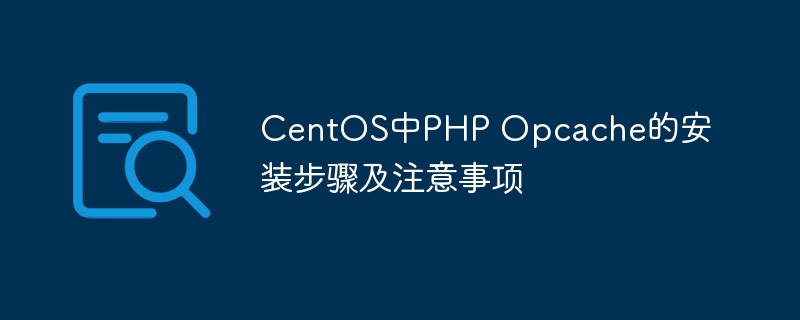Installation steps and precautions for PHP Opcache in CentOS

Installation steps and precautions for PHP Opcache in CentOS
When using PHP to develop websites, in order to improve performance and speed up page loading, we usually use Opcache. Cache PHP code, reducing access to hard disk and memory, thus improving website performance. This article will introduce the detailed steps and some precautions for installing PHP Opcache under CentOS system.
1. Install PHP Opcache
1. Update the system and install the necessary software packages
First, make sure your CentOS system has been updated to the latest version and install the necessary Software packages, including PHP and related extensions:
sudo yum update sudo yum install epel-release sudo yum install php php-opcache
2. Configure Opcache
Next, edit the PHP configuration file php.ini, enable the Opcache extension and configure Related parameters:
sudo nano /etc/php.ini
Add the following configuration in php.ini:
[opcache] zend_extension=opcache.so opcache.enable=1 opcache.enable_cli=1 opcache.memory_consumption=128 opcache.interned_strings_buffer=8 opcache.max_accelerated_files=4000 opcache.validate_timestamps=0 opcache.revalidate_freq=0 opcache.fast_shutdown=1
After saving and closing the file, restart the PHP-FPM service to make the modifications effective:
sudo systemctl restart php-fpm
3. Verify the installation
In order to ensure that Opcache has been successfully installed and effective, you can create a PHP file, output the phpinfo() information, and access it in the browser. You should be able to see Opcache related information in the output information, indicating that the installation is successful.
2. Notes
1. Cache cleaning
When updating the PHP code of the website, it is best to manually clean the Opcache cache to ensure that the new code can take effect immediately. You can clean up Opcache through the following command:
sudo php -r 'opcache_reset();'
2. Monitor performance
In order to better understand the performance of Opcache, you can use some tools to monitor the usage of Opcache, such as Zend Opcache GUI, etc. , so that parameters can be adjusted in time to optimize performance.
3. Regular tuning
As website traffic and business needs change, it is recommended to regularly check the performance of Opcache and adjust the configuration parameters according to the actual situation to ensure high-performance operation of the website.
Through the above steps and precautions, you can successfully install and configure PHP Opcache on CentOS systems and improve your website performance and user experience. Hope this article helps you!
The above is the detailed content of Installation steps and precautions for PHP Opcache in CentOS. For more information, please follow other related articles on the PHP Chinese website!

Hot AI Tools

Undresser.AI Undress
AI-powered app for creating realistic nude photos

AI Clothes Remover
Online AI tool for removing clothes from photos.

Undress AI Tool
Undress images for free

Clothoff.io
AI clothes remover

AI Hentai Generator
Generate AI Hentai for free.

Hot Article

Hot Tools

Notepad++7.3.1
Easy-to-use and free code editor

SublimeText3 Chinese version
Chinese version, very easy to use

Zend Studio 13.0.1
Powerful PHP integrated development environment

Dreamweaver CS6
Visual web development tools

SublimeText3 Mac version
God-level code editing software (SublimeText3)

Hot Topics
 CakePHP Project Configuration
Sep 10, 2024 pm 05:25 PM
CakePHP Project Configuration
Sep 10, 2024 pm 05:25 PM
In this chapter, we will understand the Environment Variables, General Configuration, Database Configuration and Email Configuration in CakePHP.
 PHP 8.4 Installation and Upgrade guide for Ubuntu and Debian
Dec 24, 2024 pm 04:42 PM
PHP 8.4 Installation and Upgrade guide for Ubuntu and Debian
Dec 24, 2024 pm 04:42 PM
PHP 8.4 brings several new features, security improvements, and performance improvements with healthy amounts of feature deprecations and removals. This guide explains how to install PHP 8.4 or upgrade to PHP 8.4 on Ubuntu, Debian, or their derivati
 CakePHP Date and Time
Sep 10, 2024 pm 05:27 PM
CakePHP Date and Time
Sep 10, 2024 pm 05:27 PM
To work with date and time in cakephp4, we are going to make use of the available FrozenTime class.
 CakePHP File upload
Sep 10, 2024 pm 05:27 PM
CakePHP File upload
Sep 10, 2024 pm 05:27 PM
To work on file upload we are going to use the form helper. Here, is an example for file upload.
 CakePHP Routing
Sep 10, 2024 pm 05:25 PM
CakePHP Routing
Sep 10, 2024 pm 05:25 PM
In this chapter, we are going to learn the following topics related to routing ?
 Discuss CakePHP
Sep 10, 2024 pm 05:28 PM
Discuss CakePHP
Sep 10, 2024 pm 05:28 PM
CakePHP is an open-source framework for PHP. It is intended to make developing, deploying and maintaining applications much easier. CakePHP is based on a MVC-like architecture that is both powerful and easy to grasp. Models, Views, and Controllers gu
 How To Set Up Visual Studio Code (VS Code) for PHP Development
Dec 20, 2024 am 11:31 AM
How To Set Up Visual Studio Code (VS Code) for PHP Development
Dec 20, 2024 am 11:31 AM
Visual Studio Code, also known as VS Code, is a free source code editor — or integrated development environment (IDE) — available for all major operating systems. With a large collection of extensions for many programming languages, VS Code can be c
 CakePHP Creating Validators
Sep 10, 2024 pm 05:26 PM
CakePHP Creating Validators
Sep 10, 2024 pm 05:26 PM
Validator can be created by adding the following two lines in the controller.






